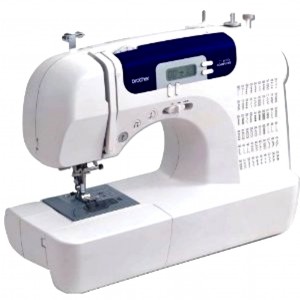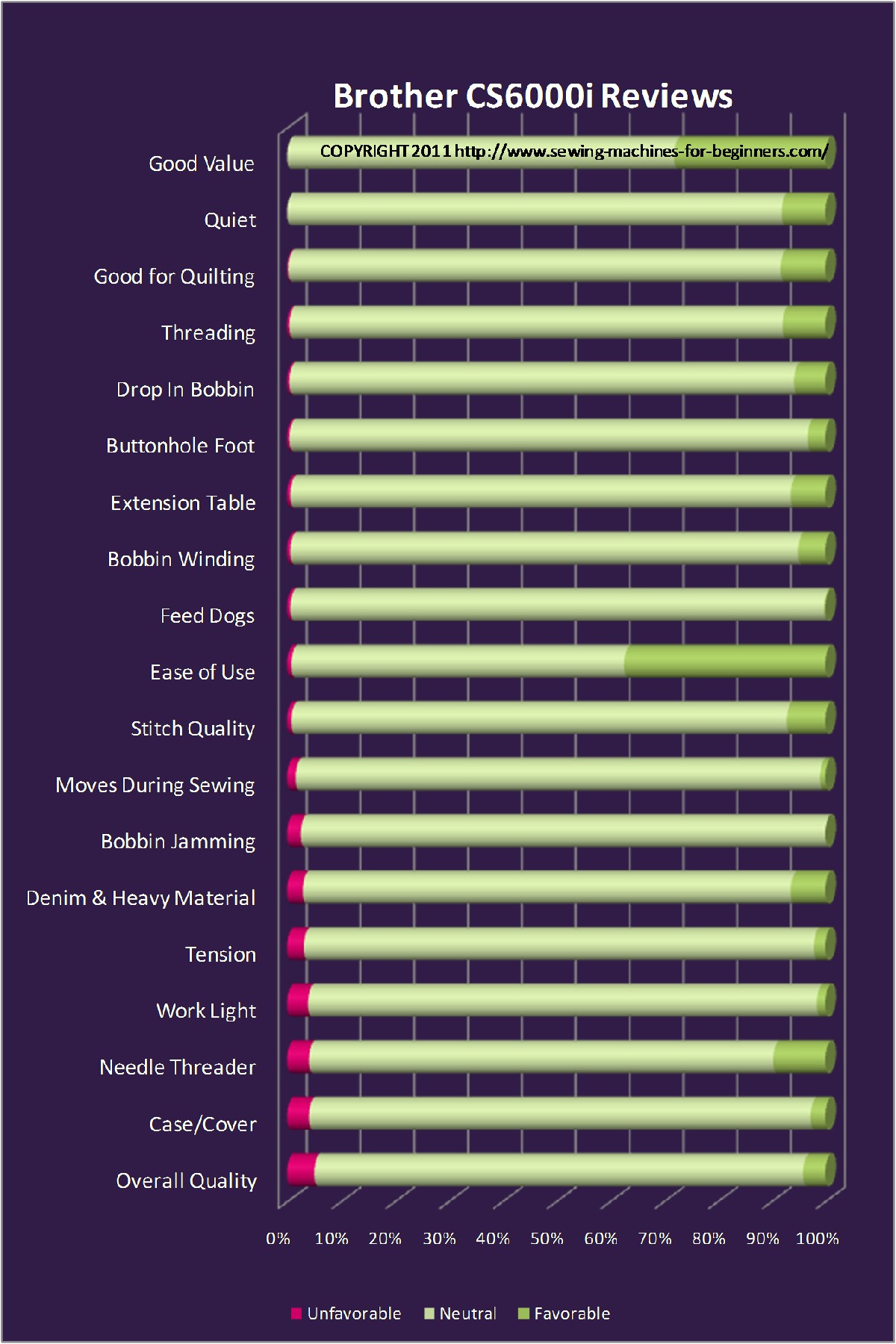 How’s this for easy? Over 500, independent Brother CS6000i reviews boiled down into one, easy-to-read graph. Get all the facts about strengths, complaints, and repeating issues from others who have used the machine without spending hours and hours reading each, individual page yourself.
How’s this for easy? Over 500, independent Brother CS6000i reviews boiled down into one, easy-to-read graph. Get all the facts about strengths, complaints, and repeating issues from others who have used the machine without spending hours and hours reading each, individual page yourself.
The source for this information is the 517 reviews on Amazon – all 52 pages of them. It took days to read and categorize the information. It felt like there should be an easier way to present the most important information for anyone who wants to compare this machine to the other possibles on their list.
Sure, online sites are great at showing you a star system but when it comes to sewing machines a star rating isn’t enough. A star doesn’t say “this is a great sewing machine for quilting”, or “this machine doesn’t work on denim”. It just means that someone who bought the machine thought it was great for them but your needs and expectations might be different.
The following chart shows you all of the most mentioned positives and negatives found in those 517 comments.

How to Read the Review Chart
Each line represents an important factor in analyzing this machine. The deep pink bar shows the share of people who mentioned this factor in a negative way. These were considered “unfavorable” reviews. The dark green bar represents the share of people who mentioned this factor in a positive way – “favorable”. The light green bar in the middle of each line represents those who didn’t mention the factor at all in their review and so were classified as being “neutral” on the subject.
They’re sorted by the number of negative reviews, smallest to largest. The negatives that came up most often can be found on the bottom of the chart.
Complaints
I know – “Cool looking graph, Erin…what the heck does it all mean?”
I’m a really positive person but when it comes to spending money I want to know the negatives first. Get all the scary stuff on the table. If anything removes an item from my list of candidates it’s likely to be something on the list of negatives that does it.
So, starting at the bottom of the chart with the most often mentioned complaints and working our way up, here are the eight worst complaints. If you’re considering buying this machine, ask yourself if you could live with each of these potential issues:
 Overall Quality – You might get a lemon. Yes. It could happen. In fact, it is the single worst thing that could happen if you buy this machine. Approximately 5% of those who took the time to write a review actually ended up returning the item because it didn’t work and they mentioned the quality of the machine in their reasoning. Many of these complaints were the result of some horrible clunking noises and a misalignment between the bobbin casing and the needle. HOWEVER, there were almost as many positive remarks regarding the overall quality of the machine as there were negatives. Considering the small percentage of return/quality issues, the chances of getting a lemon are acceptably, attractively low.
Overall Quality – You might get a lemon. Yes. It could happen. In fact, it is the single worst thing that could happen if you buy this machine. Approximately 5% of those who took the time to write a review actually ended up returning the item because it didn’t work and they mentioned the quality of the machine in their reasoning. Many of these complaints were the result of some horrible clunking noises and a misalignment between the bobbin casing and the needle. HOWEVER, there were almost as many positive remarks regarding the overall quality of the machine as there were negatives. Considering the small percentage of return/quality issues, the chances of getting a lemon are acceptably, attractively low.
 Case/Cover – You might be surprised to find the included case is not a case so much as a hard shell cover. This was a problem for a number of consumers who expected a carrying case with their purchase. Instead, this is a hard plastic cover which sits over the machine while not in use. It does not have a bottom. It cannot hold any of the accessories. It doesn’t even work to keep the machine free from dust because there is a hole in the top for the handle on the machine to fit through. You can carry the machine by using the handle through that hole and it does keep little hands off of your sewing machine to have it covered while not in use. If you want to cart your machine around with all of the attachments and accessories, you can buy an actual carrying case or bag.
Case/Cover – You might be surprised to find the included case is not a case so much as a hard shell cover. This was a problem for a number of consumers who expected a carrying case with their purchase. Instead, this is a hard plastic cover which sits over the machine while not in use. It does not have a bottom. It cannot hold any of the accessories. It doesn’t even work to keep the machine free from dust because there is a hole in the top for the handle on the machine to fit through. You can carry the machine by using the handle through that hole and it does keep little hands off of your sewing machine to have it covered while not in use. If you want to cart your machine around with all of the attachments and accessories, you can buy an actual carrying case or bag.
 Needle Threader – You might not be able to figure out the automatic needle threader. Some couldn’t. Some could and raved about it. In fact, there were more favorable comments about the automatic needle threader than there were negative comments. I have one on my machine and I know they can be picky but unless you’re buying a high-end, commercial machine most of these operate the same way so you’re not likely to escape this issue by buying a different machine on your list.
Needle Threader – You might not be able to figure out the automatic needle threader. Some couldn’t. Some could and raved about it. In fact, there were more favorable comments about the automatic needle threader than there were negative comments. I have one on my machine and I know they can be picky but unless you’re buying a high-end, commercial machine most of these operate the same way so you’re not likely to escape this issue by buying a different machine on your list.
 Work Light – You might need to buy a separate work lamp. Some people didn’t think the included LED light over the work space was bright enough. Others thought it was plenty bright. Tip: Get a separate, clamp-on snake light like the Fulcrum Multi-Flex LED Task Light, Silver
Work Light – You might need to buy a separate work lamp. Some people didn’t think the included LED light over the work space was bright enough. Others thought it was plenty bright. Tip: Get a separate, clamp-on snake light like the Fulcrum Multi-Flex LED Task Light, Silver and you can highlight whatever you want whenever you want.
 Tension – You may end up fiddling with the tension. A small number of people thought the tension was off in some way and that they had to make adjustments they didn’t expect to have to make to tighten up their stitches.
Tension – You may end up fiddling with the tension. A small number of people thought the tension was off in some way and that they had to make adjustments they didn’t expect to have to make to tighten up their stitches.
 Denim & Heavy Material – You might have trouble working with really thick layers of fabric. However, there were actually more favorable comments about working with thick fabrics and denim than there were unfavorable comments. Tip: Buy and use the right heavy-duty needle and thread when working with thick fabrics and the CS6000i should do just fine.
Denim & Heavy Material – You might have trouble working with really thick layers of fabric. However, there were actually more favorable comments about working with thick fabrics and denim than there were unfavorable comments. Tip: Buy and use the right heavy-duty needle and thread when working with thick fabrics and the CS6000i should do just fine.
 Bobbin Jamming – If there’s one thing that can frustrate a sewer more than any other it’s a thread jam. Some people experienced just such a problem. Tip: Using high quality thread and replacement bobbins was often the fix.
Bobbin Jamming – If there’s one thing that can frustrate a sewer more than any other it’s a thread jam. Some people experienced just such a problem. Tip: Using high quality thread and replacement bobbins was often the fix.
 Moves During Sewing – The machine might jump around when you sew with large amounts of heavy fabric. When the fabric weighs more than your lightweight machine, this is a possibility. Tip: Put the machine on a non-skid mat to stop it from moving on you.
Moves During Sewing – The machine might jump around when you sew with large amounts of heavy fabric. When the fabric weighs more than your lightweight machine, this is a possibility. Tip: Put the machine on a non-skid mat to stop it from moving on you.
All of the remaining factors had far more positive comments than negative. Repeatedly, consumers loved how easy it was to use, what a great value they got for their money, the stitch quality, the drop-in bobbin, the easy threading, the extension table, how quietly the machine operated, and how great it was for quilting. (Look at the longest, dark green bars to find the most favorably rated factors.)
That’s it. There’s no hidden secret. There’s nothing left to uncover. There’s a small chance you get a lemon but that would happen with anything you buy. (Just ask me. I’ve bought my share of bad products throughout the years!)
The chances are far better – HUGE, even – that you are going to end up one very happy person when you realize what a great machine you get for such a low price.
You can read through the actual comments yourself here: Reviews on Amazon.
How the Reviews were Categorized
Every word of every review was read and the main points of each of those reviews were counted. A review might mention several good points and several bad points. Each main positive and each main negative in each review was counted somewhere on the chart.
Some factors were really easy to categorize. It’s amazing how many reviewers specifically said “easy to use”. Every time that showed up, the factor in the chart called “Easy to Use” got another point in the dark green (favorable) column.
Certainly some interpretation had to be applied to boil all of the factors down to this consolidated list. For example, someone might have written “great value for the money” on one of the Brother CS6000i reviews and someone else might have phrased that as “you get a lot for the price”. They’re not written the same but they mean the same thing. Both of those phrases would have received another point in the dark green column for “Good Value”.
Hopefully, seeing all of the review information consolidated like this makes it easier for you to decide whether or not the buying is right for you.

Hi Erin,
Nice job and effort trying to help folks (like me) figure out which machine to buy. However, just a bit of warning… you have no way of knowing how many of the Amazon reviews … or any reviews on any site… are legit. There are companies that get paid by corporations big bucks to post phony reviews. Some, such as Universal Studios, even have their own in-house teams of people sitting at computer banks and using phony aliases to post promotional reviews for their own products while posting derogatory reviews about their competitors. I know because I worked in the online marketing field long enough to see how this works. It is unfortunate and definitely unfair… but there is simply no way to control it or to know which reviews are true. We need to go back to the old-school method of getting reviews… by asking people in person or over the phone what they think of the products they bought. Any other method is simply unreliable.
Thanks again for all the work and for such a terrific blog. Happy sewing!
Cynthia
Los Angeles
Cynthia – Excellent advice and thank you for the compliment. Believe me, I’m well aware of the behind-the-scenes activity that goes into Amazon reviews (or any online review platform, for that matter). I’m in the middle of writing an ebook about how to “read” those reviews to make sure one doesn’t get taken in. There’s a list of about 10 things folks need to know about how those reviews get created, who writes them, what they get for writing them, the Amazon Vine program, and how retailers use reviews to get their product positioned to look like a #1 Best Seller when it has no business being in such a position at all, etc. I intend for the ebook to be something my visitors can download from this site for guidance if they’re choosing to shop online for anything – not just sewing machines.
Always helps to have another insiders take on the ins and outs of internet marketing. Thank you!
Sincerely,
Erin